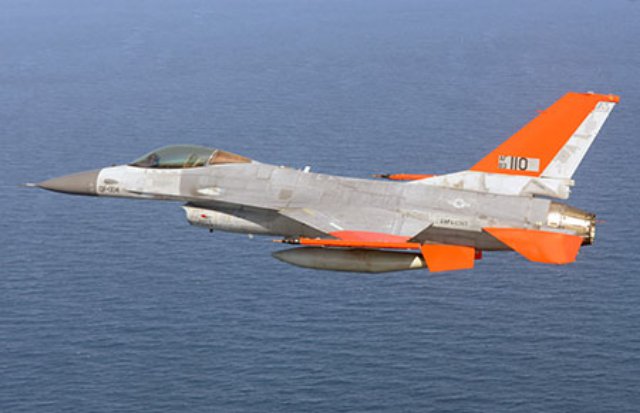There is an effort underway to develop a UAV version of the F-16. This would be based on the QF-16, the remotely controlled target version of the F-16. The air force is already in the process of converting 210 retired F-16s to QF-16s and it was noted that with a little extra work the QF-16 could be turned into a combat UAV for dangerous missions like SEAD (suppression of enemy defenses) or attacking ground targets guarded by heavy air defenses.
QF type aircraft use GPS to help with navigation and to insure that QFs flying in formation don’t collide with one another. The QF-16 also carries sensors to detect near misses by missiles.
There are several other reasons for adapting the F-16 to be a combat UAV rather than designing them from scratch. For one thing, the UAV version of any combat aircraft is superior in some ways to one with a pilot in it. This is mainly because pilots black out when the aircraft makes turns too sharply at high speed. By the 1960s fighter aircraft design had reached the point where the aircraft could perform maneuvers (like high speed turns) that humans could not handle. The air force discovered how effective this capability was during the 1970s, when they rigged some jet fighters to fly without a pilot and had them go up against manned aircraft. The remote controlled fighters were able to outmaneuver the same aircraft carrying pilots.
The QF-16 has already demonstrated its ability to carry out acrobatic maneuvers under remote control. This would be useful in getting into heavily defended air space. Adding more sensors and flight control software could produce a formidable combat UAV. Even when all the QF-16 conversions are completed there will be several hundred retired F-16s suitable for conversion to combat UAVs.
The air force ordered the first QF-16s in 2010 and one flew for the first time in September 2013. These unmanned F-16s are for use as aerial targets. The QF-16s are converted from existing F-16s that have been retired from service. About a dozen QF-16s have been produced so far, which mainly consists of installing hardware and software that enables remote (no pilot in the cockpit) flight control. The process of equipping the F-16 with all the necessary sensors (cameras and remote feeds of the aircraft radar) and remote capabilities took longer than expected, even though there was a lot of experience doing this to older aircraft (F-4s, F-100s, F-102s, and F-106s). The original plan was to introduce the first QF-16s in 2011. The QF-16s can still carry a pilot who can fly the aircraft or simply observe how the remote control process is working.
The QF-16 replaces the older QF-4 drone aircraft. Nearly 250 F-4 Phantom fighters were modified to fly by remote control. The mods cost about $1.4 million per aircraft. The QF-4 first appeared when the U.S. Air Force retired its F-4 fighters in the 1980s. The air force has run out of retired (but still flyable) F-4s to convert and QF-4 conversions ceased in 2013.
Training operations destroy up to 25 remotely controlled QF class fighters a year. The existing supply of decommissioned F-4s is exhausted and the QF-16s are arriving just in time. Before the QF-4, the air force had converted 218 F-100s (for use from 1983-92), 136 F-102s (from 1974-85), and 210 F-106s (1990-98) to act as full scale target aircraft. There are smaller UAVs that are also used as targets. The full scale models are needed to fully test the capabilities of new, and existing, missiles. Nothing like using real missiles against real targets to build pilot confidence and be sure the damn things work.
But there are so many retired F-16s available that there are plenty that could be used as combat UAVs. The F-16 manufacturer (Lockheed) is not doing the UAV conversion research, but rather another aircraft company (Boeing) which sees a potential market for such aircraft. These UCAVs (Unmanned Combat Aerial vehicles) already exist as the MQ-1 Predator and MQ-9 Reaper. But an MQ-16 Lawn Dart (the unofficial nickname for the F-16) would be cheaper. This would be an inexpensive way to see what a more ambitious (and larger) UCAV could do.
Source: Strategy Page


A unique idea, but probably underestimates the engineering required to make an MQ-16. Would the MQ-16 be remotely controlled like Reaper? Datalinks will be important, especially for longer ranges. Until autonomous air-to-air refueling is perfected and operational, any MQ-16 would have pretty limited range.
And I think in the second paragraph, it should be “ensure” there are no collisions, not “insure”, which is what you do at GEICO.